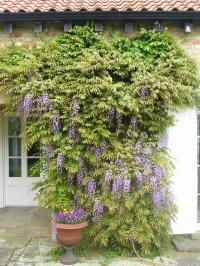How and When to Prune Wisteria
 Wisteria can become invasive so require regular pruning
Wisteria can become invasive so require regular pruningA short guide to the correct pruning of Wisteria, a job that needs to be done in late Winter in the garden.
Pruning a Wisteria should be carried out twice per year. Two prunings per year not only helps in the development of flowers, it also keeps the Wisteria in check; they can be incredibly invasive plants if left unpruned
Mid to late winter, is one of the times in the calendar when the pruning should be done. Pruning is then carried out again during July.
If the pruning is not carried out correctly the plant produces too much vegetative wood at the expense of flowers (as demonstrated in the photograph). Unless they are being used to extend or improve the framework, the vigorous young vegetative shoots need to be strongly curtailed to encourage flower production. The plantís energy needs to be diverted into producing flowers and this is best achieved with pruning.
If you intend to prune a very neglected, twisted and totally out of control Wisteria, some pruning of the very woody older stems may be required, but under normal circumstances this older wood, that forms the framework of an established Wisteria is left unpruned.
Regardless of what is going on with the older stems, which are often inter-twined and difficult to prune, the main aim is to get the younger shoots that are easy to work with growing in a horizontal row formation along the space you have to fill. This will create the correct framework shape for future years. It is off these horizontal stems that shoots with the potential to develop flower spurs will be produced and if pruned properly and at the correct time of year they will produce a good show of blooms.
Use the following steps to prune your Wisteria:
- Identify the stems that form the framework of your Wisteria. Do not cut or prune any of these unless you need to start afresh with the training because the framework shape is incorrect.
- Have a definite picture in your head of how the Wisteria should look in years to come, it should have a central upright stem, (or realistically a plat of several mature upright stems) off which mature horizontal laterals produce the flower bearing shoots. Wisteria flowers are more likely to be produced on short spurs originating from horizontal shoots.
- It is only the younger, greener more flexible vegetative shoots that need to be pruned if the woody framework already has the correct shape. The young green shoots are often out of control and can grow up to 4 metres in a single year. With each young green shoot, decide if it is to be kept, to be tied in as a new horizontal framework shoot. As you choose the new horizontal framework shoots they should be tied on to strong horizontal wires. If you decide that the young shoot is not required as a new framework shoot, it can be converted into a flower bearing spur. Trace it back to the horizontal shoot from which it originates and cut it back to 2 or 3 buds after the point at which it protrudes, leaving a short spur. Pruning these shoots in this way encourages the short spur to produce flowers.
- Then in July, after flowering, cut back the same shoots again, but this time not so short; 5 or 6 buds in length. This second pruning allows more light and air to be absorbed by the older woody framework, encouraging it to ripen and therefore develop more flower buds.
Wisterias do need twice as much pruning as most other climbers, but your hard work will be rewarded; there is no finer site in horticulture than a well pruned Wisteria in full bloom during early summer.
Filed under DIY Gardening Jobs.

